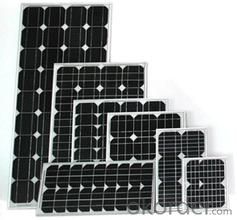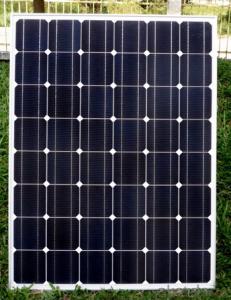Poly Solar Panel 70W A Grade with 12 Years Warranty
- Loading Port:
- Shanghai
- Payment Terms:
- TT OR LC
- Min Order Qty:
- 100 watt
- Supply Capability:
- 1000 watt/month
OKorder Service Pledge
OKorder Financial Service
You Might Also Like
Item specifice
Poly Solar Panel 70W A Grade with 12 Years Warranty
Production description
Solar power is the conversion of sunlight into electricity, either directly usingphotovoltaics (PV), or indirectly using concentrated solar power (CSP). Concentrated solar power systems use lenses or mirrors and tracking systems to focus a large area of sunlight into a small beam. Photovoltaics convert light into an electric currentusing the photovoltaic effect.[1]
The International Energy Agency projected in 2014 that under its "high renewables" scenario, by 2050, solar photovoltaics and concentrated solar power would contribute about 16 and 11 percent, respectively, of the worldwide electricity consumption, and solar would be the world's largest source of electricity. Most solar installations would be in China and India.[2]
photovoltaic system, also solar PV power system, or PV system, is a power system designed to supply usable solar power by means of photovoltaics. It consists of an arrangement of several components, includingsolar panels to absorb and convert sunlight into electricity, a solar inverter to change the electric current from DC to AC, as well as mounting, cabling and other electrical accessories to set up a working system. It may also use a solar tracking system to improve the system's overall performance and include an integrated battery solution, as prices for storage devices are expected to decline. Strictly speaking, a solar arrayonly encompasses the ensemble of solar panels, the visible part of the PV system, and does not include all the other hardware, often summarized as balance of system (BOS). Moreover, PV systems convert light directly into electricity and shouldn't be confused with other technologies, such as concentrated solar power or solar thermal, used for heating and cooling.
Application
Commercial
Industrial
Residential
Product Feature
12 years quality warranty 25 years performance output.
Free for less than 5 pcs sample requirement
Free to replace or repair or refund if products fail to conform to the PI requirement.
Packaging
28pcs into carton 2carton into pallets 28pallets into a 40ft container
Delivery
After 25 days for manufacturered goods as soon as we received full payment.
After 10 days for stock goods as soon as we received full payment.
- Q:What is 3d solar cell? And anybody know any manufacturers?
- 3d solar cells are more high efficient than the usual solar cells, and it's a new developed technology which is not used very widely. Therefore, there are not many manufcturers are producing it.
- Q:What is the impact of solar cells on wildlife?
- The impact of solar cells on wildlife is generally minimal and beneficial. Solar cells produce clean energy without emitting harmful pollutants or greenhouse gases, reducing air and water pollution that can negatively affect wildlife habitats. Additionally, solar energy infrastructure typically occupies a small footprint and can coexist with wildlife habitats, allowing animals to continue their normal behaviors. However, there have been some concerns about the potential for bird collisions with solar panels and the disruption of desert ecosystems during large-scale solar installations. Overall, compared to traditional energy sources, solar cells have a much lower impact on wildlife and contribute to a more sustainable future.
- Q:Are solar cells safe for the environment?
- Yes, solar cells are safe for the environment. They generate electricity using sunlight, which is a clean and renewable energy source. Solar cells do not emit any greenhouse gases or pollutants during operation, making them an environmentally friendly energy solution. Additionally, they have a long lifespan and can be recycled, reducing their overall impact on the environment.
- Q:Solar cell life for several years
- In physics called solar photovoltaic (Photovoltaic, photo light, voltaics volts, abbreviated as PV), referred to as photovoltaic.
- Q:What is the impact of saltwater exposure on solar cell efficiency?
- Saltwater exposure can have a significant negative impact on solar cell efficiency. The saltwater can corrode the metal components of the solar cells, leading to a decrease in their performance and overall efficiency. Additionally, the saltwater can create a conductive pathway that can bypass the solar cells, resulting in a loss of electrical energy. Therefore, it is crucial to protect solar cells from saltwater exposure to maintain their efficiency and prolong their lifespan.
- Q:Can solar cells be used in underwater vehicles or submarines?
- Yes, solar cells can be used in underwater vehicles or submarines. However, they have certain limitations due to the reduced availability of sunlight underwater. To overcome this challenge, the solar cells used in these vehicles are usually highly efficient and designed to operate even in low-light conditions. Additionally, the surface area of solar panels may need to be increased to compensate for the reduced sunlight intensity.
- Q:What is the role of power optimizers in solar cell systems?
- Power optimizers play a crucial role in solar cell systems by maximizing the energy output of each individual solar panel. They work by individually monitoring and optimizing the performance of each panel, thereby minimizing power losses caused by shading, mismatch, and other factors. This optimization helps to improve the overall efficiency and reliability of the solar system, ensuring that it operates at its highest potential and delivers maximum energy yields.
- Q:What is the right way to operate a solar cell?
- It is difficult to operate the solar cell because it is high technology related.
- Q:What is the maintenance required for solar cells?
- The maintenance required for solar cells primarily involves periodic cleaning to ensure maximum sunlight absorption, checking for any damage or debris, and monitoring the performance of the system to address any issues promptly. Additionally, regular inspections and maintenance of other components such as inverters, wiring, and batteries may be required to ensure optimal functioning and longevity of the solar cell system.
- Q:How much energy can a solar cell generate?
- The amount of energy a solar cell can generate depends on various factors such as its size, efficiency, and the available sunlight. On average, a standard solar cell can generate around 200 to 400 watts of electricity per square meter in optimal conditions. However, technological advancements continue to improve the efficiency of solar cells, allowing for higher energy generation in the future.
1. Manufacturer Overview |
|
|---|---|
| Location | |
| Year Established | |
| Annual Output Value | |
| Main Markets | |
| Company Certifications | |
2. Manufacturer Certificates |
|
|---|---|
| a) Certification Name | |
| Range | |
| Reference | |
| Validity Period | |
3. Manufacturer Capability |
|
|---|---|
| a)Trade Capacity | |
| Nearest Port | |
| Export Percentage | |
| No.of Employees in Trade Department | |
| Language Spoken: | |
| b)Factory Information | |
| Factory Size: | |
| No. of Production Lines | |
| Contract Manufacturing | |
| Product Price Range | |
Send your message to us
Poly Solar Panel 70W A Grade with 12 Years Warranty
- Loading Port:
- Shanghai
- Payment Terms:
- TT OR LC
- Min Order Qty:
- 100 watt
- Supply Capability:
- 1000 watt/month
OKorder Service Pledge
OKorder Financial Service
Similar products
New products
Hot products
Related keywords


























